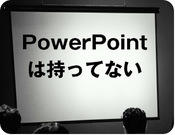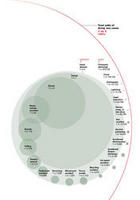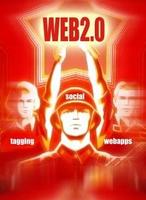| Wednesday, March 7, 2007 |  |
|
|
|
 Sounds like a porn movie. But, no, Dick Hardt is a CEO of Sxip Identity, and the point here is his style of doing a presentation. See a video of his Identity2.0 presentation at OSCon. Lots and lots of slides, with just a few words or a picture each, creating an interesting flow of a presentation, which in many ways work better than a normal powerpoint presentation with bullet points, etc. Sounds like a porn movie. But, no, Dick Hardt is a CEO of Sxip Identity, and the point here is his style of doing a presentation. See a video of his Identity2.0 presentation at OSCon. Lots and lots of slides, with just a few words or a picture each, creating an interesting flow of a presentation, which in many ways work better than a normal powerpoint presentation with bullet points, etc.
Hardt didn't invent this style, but it somehow got associated with his name. Rather, Lawrence Lessig has used it for a while, and I've seen it before in videos of his talks. So, Lessig Style would be as correct.
Interestingly, both of these guys are fairly boring speakers. If they were just standing there talking, they're not exactly great orators. But combined with a dynamic presentation like that, they're great speakers who everybody pays attention to all the time.
Hm, I've got to try that. Most Powerpoint presentations are boring. Time for some innovation.
(Via Cedric)
[ Information | 2007-03-07 22:18 | | PermaLink ] More >
|
|
| Sunday, February 25, 2007 |  |
|
|
|
 .. are 1 to 1. Some will dispute that, but so far that seems to be how it goes. But the picture shows the odds of dying of different causes. I don't see terrorist attacks there, or war or starvation, but otherwise I suppose it puts things in perspective. .. are 1 to 1. Some will dispute that, but so far that seems to be how it goes. But the picture shows the odds of dying of different causes. I don't see terrorist attacks there, or war or starvation, but otherwise I suppose it puts things in perspective.
[ Information | 2007-02-25 16:03 | | PermaLink ] More >
|
|
| Friday, February 2, 2007 |  |
|
|
|
 Vendors of products present you with more and more ridiculous agreements you supposedly have made with them by buying their product and opening the package. Whether you were aware of it or not, whether the agreement is reasonable or not, and whether it is legally enforcable or not. And agreement is in principle something that two or more people make consciously, after having negotiated the terms. Something that benefits both parties, a contract they enter into knowingly. But a EULA or shrink-wrap license is entirely different, a one-sided attempt of making you the losing side, by implying that you've agreed to something you probably haven't even read. So, time to fight back. Bumperactive produces stickers like this one. The idea is that whenever you're communicating with one of those kinds of companies, you provide them with an equally silly contract they've entered into just by talking to you, or receiving a letter from you. So, you can put stickers like that on the back of the envelope when you pay your cable bill. Or you can read out the terms on the phone when you call a vendor. You can adjust the text to your own purpose, of course, and add any additional small print that tickles your fancy. Sounds very reasonable to me. Vendors of products present you with more and more ridiculous agreements you supposedly have made with them by buying their product and opening the package. Whether you were aware of it or not, whether the agreement is reasonable or not, and whether it is legally enforcable or not. And agreement is in principle something that two or more people make consciously, after having negotiated the terms. Something that benefits both parties, a contract they enter into knowingly. But a EULA or shrink-wrap license is entirely different, a one-sided attempt of making you the losing side, by implying that you've agreed to something you probably haven't even read. So, time to fight back. Bumperactive produces stickers like this one. The idea is that whenever you're communicating with one of those kinds of companies, you provide them with an equally silly contract they've entered into just by talking to you, or receiving a letter from you. So, you can put stickers like that on the back of the envelope when you pay your cable bill. Or you can read out the terms on the phone when you call a vendor. You can adjust the text to your own purpose, of course, and add any additional small print that tickles your fancy. Sounds very reasonable to me.
[ Information | 2007-02-02 17:27 | 0 comments | PermaLink ]
|
|
| Wednesday, January 31, 2007 |  |
|
|
|
 I love all kinds of website widgets that let you visualize something in the world in real time. I love all kinds of website widgets that let you visualize something in the world in real time.
How about emergencies and disasters going on right now on the world map.
You can see the ships moving around in San Francisco Bay.
There are airport traffic monitors.
You can see where there's sunlight on the planet right now.
You can see the cloud cover in your area right now.
And of course you can see who's blogging in the world right now.
Actually there isn't really that much available that you can see in real-time. I wish this was coordinated a little more, so there were just a few key places you could go to visualize most of what's going on right now.
Some people, like the Geosphere Project have worked on ways of unifying global information, although it doesn't look like much, but they're the guys who created the famous cloudfree picture of the Earth.
[ Information | 2007-01-31 18:00 | | PermaLink ] More >
|
|
| Friday, January 26, 2007 |  |
|
|
|
 The Ad Generator: The Ad Generator:The ad generator is a generative artwork that explores how advertising uses and manipulates language. Words and semantic structures from real corporate slogans are remixed and randomized to generate invented slogans. These slogans are then paired with related images from Flickr, thereby generating fake advertisements on the fly. By remixing corporate slogans, I intend to show how the language of advertising is both deeply meaningful, in that it represents real cultural values and desires, and yet utterly meaningless in that these ideas have no relationship to the products being sold. In using the Flickr images, the piece explores the relationship between language and image, and how meaning is constructed by the juxtaposition of the two. It is kind of uncanny. Some of them are off, but a lot of them really work.
Now, sitting watching something like that, do you think that possibly might make you immune to the manipulation of advertising? You know, because you can see through it, or maybe because you can appreciate the beauty of random pushing of emotional buttons. I wish, at least.
[ Information | 2007-01-26 15:53 | | PermaLink ] More >
|
|
| Sunday, January 7, 2007 |  |
|
|
|
Lawrence Lessig delivered an excellent speech at the Chaos Communication Congress, which you can see here. He talked in part about if we don't succeed in changing copyright laws so that we can do the creative things we naturally do, like mash-ups, we can at least switch our preferences over to alternative systems, like obviously Creative Commons. If enough people just start preferring alternative licenses to 95 year locked-away copyrights, things will change. And to comment on Lessig's speech there's then an interview with John Perry Barlow. Who, in usual style says it more directly and poetically. Like, to answer the question of how we might succeed in crashing the old system:If you wanna share something - share it. If you wanna use something - use it. Try to do so ethically in the sense that, you know, don’t take things without attribution, attribute. Make sure that the people who did create actually have the opportunity to get some enhanced reputation and thereby, you know, greater economic return. But, you know, pay no attention to these people when it comes to being creative. Go ahead and do the stuff that Larry showed in the beginning of his talk and do lots of it. And every time they put a lock on - break it. And every time they pass a new law - break that. You know. Sooner or later they’re dealing with such a massive level of civil disobedience that they have to address it. And that’s where we’re headed in a, I think, a hell of a hurry. I mean, you go to California and you drive down the 280, which is sort of the main artery of Silicon Valley and connects to San Francisco, and all those cars are going 85 mph where the speed limit is 65. But it’s a good road and there are good cars generally and they’re good drivers and there’s not a damn thing anybody can do about it. What are they gonna do? Arrest the entire highway? No. So the cops are right there cruising along with you at 85 mph. And that’s still against the law but nevertheless people have asserted the freedom to drive as fast as they think which is reliably safe under those circumstances. And we have to do the same thing. Clearly and obviously. Oppressive and senseless laws only stay in place because most people willingly go along with them. They can't sue or arrest everybody, however many corrupt politicians they have on their side. They still need to make money, and the politicians still need to get re-elected, and if nobody buys their stuff and nobody votes for them, it just ain't happening.
[ Information | 2007-01-07 23:05 | | PermaLink ] More >
|
|
| Monday, January 1, 2007 |  |
|
|
|
 On the subject of life stories, Euan sent me a link to dandelife. Wow, that's an interesting idea. OK, people write all sorts of stuff in their blogs already, but here the idea is to do it on a site with a lot of other people, and plot significant events in your life on a time line. Like on the 18 August, 1980, a guy named Aaron has this entry: On the subject of life stories, Euan sent me a link to dandelife. Wow, that's an interesting idea. OK, people write all sorts of stuff in their blogs already, but here the idea is to do it on a site with a lot of other people, and plot significant events in your life on a time line. Like on the 18 August, 1980, a guy named Aaron has this entry:I started first grade at Edgefield Elementary on 38th St. in Canton, OH. I was put into speach class, because I couldn't pronounce my R's. I met Danny Higgins and Arnie Bloom. Arnie looked like he sounds. He always had a caved in chest and weak constitution. Danny and I became best friends for the time being. Eventually we reconnected in High School. He dogged me out to hang with the so called cool kids. I gave him the cold shoulder for the next seventeen years. Then when my mom died I called him. He said he'd come to calling hours. When he left me a voicemail saying he couldn't make, but still wanted to grab a drink later I took it as he didn't want to be inconvenienced by driving 20 minutes out of his way. So again, I reinstated the cold shoulder. It kinds of add a different dimension, and it is surreal to wander around in those postings. I don't know why, but it is more strange than just reading a bunch of blogs in an aggregator. More personal, and somehow more real because there are dates on it, and you can access many people's stuff. Scarey in terms of privacy, although nobody forces anybody to post anything there. But intriguing in the possibilities it evokes. I'd kind of like to be able to go to a certain day and time and place and see what other people have to say about it. There's otherwise no organized way of doing that. I can search in Google, but it would really be much nicer if it is stored in a semantic way, already marked with the coordinates.
[ Information | 2007-01-01 18:08 | 0 comments | PermaLink ]
|
|
| Saturday, December 9, 2006 |  |
|
|
|
Five Great Ways to Harness Collective Intelligence. Dion Hinchcliffe outlined some potent ways that web software can leverage collective intelligence. (Via Blog of Collective Intelligence). 1) Be The Hub of A Hard To Recreate Data Source - This is a classic Web 2.0 concept and success here often devolves to being the first entry with an above average implementation. Examples include Wikipedia, eBay, and others which are almost entirely the sum of the content their users contribute. And far from being a market short on remaining space, it's lack of imagination that's often the limiting factor for new players. There is so much more terrific software like digg and del.icio.us waiting to be created. So don't wait until it's perfect, get your collective intelligence technique out there that creates a user base virtually on its own from the innate usefulness of its data. Just be careful and avoid crowded niches, like peer production news.
2) Seek Collective Intelligence Out - This is the Google approach. There is an endless supply of existing information waiting out there on the Web to be analyzed, derived, and leveraged. In other words, you can be smart and use what already exists instead of waiting for it to be contributed. For example, Google uses hyperlink analysis to determine the relevance of a given page and builds its own database of content which it then shares through its search engine. Not only does this approach completely avoid a dependency on the ongoing kindness of strangers it also lets you build a very big content base from the outset. This ultimately has interesting intellectual property implications, as I've discussed before.
3) Trigger Large-Scale Network Effects - This is what Katrinalist and CivicSpace did and many others have done. This is arguably harder to do than either of the methods above but it can be great in the right circumstance. With one billion connected users on the Web, the potential network effects are theoretically almost limitless. Smaller examples can be found in things like the Million Dollar Pixel Page. That's not to say that network effects don't cut both ways and are probably not very repeatable, but when they happen, they can happen big.
4) Provide A Folksonomy - Self-organization by your users can be a potent force to allow the content on your site or social software to be used in a way that more befits your community. It's the law of unintended uses again, something Web 2.0 design patterns strongly encourage. Allow users to tag the data they contribute or find and then make those tags available to others so they can discover and access things in dynamically evolving categorization schemes. Use real-time feedback to display tag clouds of the most popular tags and data; you'll be amazed at how much better your software works. It worked for Flickr and del.icio.us and it'll probably work for you too.
5) Create a Reverse Intelligence Filter - Like Ellyssa points out, the blogosphere is the greatest example of this and sites like Memeorandum have been using this to great effect. The idea is that hyperlinks, trackbacks, and other information references can be counted and used as a reference to determine what it's important. Combined with temporal filters and other techniques and you can create situation awareness engines easily. It sounds similar to #2 but it's different in that it can be used with or without external data sources and is aimed not at finding but at eliding the irrelevant altogether as an active filter. Make cool software, change the world, get rich, I'm all for it. I don't really have anything to add right now. This is an excellent list of hints for how to do something on the web that'll have a big effect. But then again, the list is a little old, as is the Web2.0 buzzword, so maybe there's something new we're missing.
[ Information | 2006-12-09 23:11 | | PermaLink ] More >
|
|
| Sunday, November 19, 2006 |  |
|
|
|
AndroidTech, Web 3.0 - You Ain't Seen Nothing Yet!. Isn't it a little early to try to say what Web3.0 is, when we haven't entirely agreed what Web2.0 is? I guess not. I feel that Web 3.0 will be characterized and fueled by the successful marriage of artificial intelligence and the web. Artificial Intelligence? Isn't that the kool-aid that the Semantic Web community is drinking? Yes and no. The technologies considered pivotal in the Semantic Web are indeed considered by many to have their underpinnings in artificial intelligence. But, most of the Semantic Web projects I've seen are focused squarely on the creation of, and communication between, intelligent agents that do the natural language and topical matching work in a transparent manner, behind the scenes, without requiring human intervention.
This approach may eventually be viable but I feel that it misses a key ingredient of Web 3.0 that will finally bring artificial intelligence to the forefront. Currently the vast majority of artificial intelligence is embedded in various niche areas of commerce such as credit card fraud detection, or the speech recognition application that converts your voice to text as you dictate a document, etc. The reason for this of course is that we are still decades away from computers that will have the incredible and flexible pattern recognition capabilities of the human brain. Well, right, yeah. Artificial Intelligence looked very promising 30 years ago, and it maybe still does, but I haven't noticed much progress, other than that faster computers can make something look a bit intelligent by brute force. But what he's thinking about is not really AI, but this kind of thing: The reason Web 3.0 will lift artificial intelligence into the limelight is it will fill in the technological gaps that currently hamper the key uses for artificial intelligence. It will do so by shunting out the parts of the problem that require a human being to human beings with the help of the web. But, it will do so in a manner that is transparent, massively parallel, and distributed.
Amazon has taken a unique and innovative step into this area with their Mechanical Turk web service. Yes I know this is the second time I've written glowingly about Amazon in regards to Web 3.0, but as a web service junkie you have to love what they are doing. The Turk service allows developers to shunt out the parts of their applications that require human intervention to a paid participating group of volunteer workers, in a manner that mimics a standard web service call. This creates a standardized platform for utilizing human pattern recognition capacity in a modular manner. Google is another company experimenting with something similar with their Google Image Labeler game. From the game page:
"You'll be randomly paired with a partner who's online and using the feature. Over a 90-second period, you and your partner will be shown the same set of images and asked to provide as many labels as possible to describe each image you see."
The players have fun and Google gets thousands of images tagged with relevant text labels. Wow, I have played that, and I didn't even get the point. That's brilliant, of course. Use human intelligence for something productive, have fun, or get paid for it.
That might somehow become an important trend. But that's essentially a Web2.0 kind of thing, to individually tag stuff and to collectively produce a bunch of ordered stuff.
I'd hope Web3.0 would be a cyberspace kind of thing. I mean cyberspace as flying around in multi-dimensional space and all the data you need and want being layed out visually in a way that's useful to you. "Computer, show me all the people I know, sorted by hair color!" But we're kind of far off from that, as computers still operate with a desktop metaphor, with filing cabinets and documents. And even 3D environment mostly just try to look like the regular 3D world with added improvements. Looking at a webpage on a virtual screen in a virtual world doesn't make it any better at all. We need something with more dimensions, and where you actually can look at enormous amounts of data in a useful and intuitive way. But maybe that's too much to ask, and maybe that'll be Web9.0 or something.
[ Information | 2006-11-19 22:27 | | PermaLink ] More >
|
|
| Sunday, October 22, 2006 |  |
|
|
|
Aoccdrnig to a rscheearch at an Elingsh uinervtisy, it deosn't mttaer in waht oredr the ltteers in a wrod are, the olny iprmoetnt tihng is taht frist and lsat ltteer is at the rghit pclae. The rset can be a toatl mses and you can sitll raed it wouthit porbelm. Tihs is bcuseae we do not raed ervey lteter by itslef but the wrod as a wlohe.
[ Information | 2006-10-22 18:57 | | PermaLink ] More >
|
|
| Friday, October 20, 2006 |  |
|
|
|
 It used to be that to attract attention to a message you'd make it bigger, more colorful, more important-sounding. "Danger, don't touch the electrical wires!" It used to be that to attract attention to a message you'd make it bigger, more colorful, more important-sounding. "Danger, don't touch the electrical wires!"
But advertising started to mess that up. Gradually, the most attention-grabbing, big, colorful, attractive messages are simply the ones that want to sell you something, but that aren't important at all.
Then there was spam. When I get a message that says "Important, Urgent" in the subject line, and its priority is set to high, and it has an attachment, I can pretty much just click the spam button right away. The messages that most try to grab my attention are most likely the ones that I'd least want to see.
But it is horrible for good communication. We get used to specifically ignoring the loudest messages. We sort of reverse our instinctive filters. We no longer see the banner ads on web pages, particularly because they're big and colorful, centrally placed, and moving.
What if somebody actually has something to say? How should they get my attention?
Now, recently, I seem to get a lot of junk messages to my ICQ instant messenger account. Some of it spam, but most of it from people who find me listed. I can't seem to find out how to turn that off. Most of them will try something like "hi" or "hello". Which used to mean "hi" or "hello", i.e. a friendly way of starting a conversation. But I don't want a conversation with some teenager in China who wants to practice speaking English. So, I click the block button right away and close the window. That's what it has come to. Somebody says "hello" and I press the button for the hidden trap door right away, without even checking who it is.
If it is somebody I actually know, I don't click 'block', but if they start off with "hi, how are you?", I probably won't answer. Maybe not polite, but I have little interest in starting up a string of small talk messages, to find out if there possibly might be something you want to say. I'm busy.
I suppose, if you actually have something to say to me, don't say "hi". Don't send me an urgent message. Don't make it high priority. Don't print it on a colorful billboard. I don't know what I should advice you to do, then, other than say what you actually have to say in the first five words. Or I'll already have forgotten about you.
Don't get me wrong. I enjoy hearing from my friends, and I enjoy new friends. You don't have to have anything fantastic to say. But please say it, and without adding to the noise.
Are we maybe evolving into being able to recognize meaning more quickly, and quickly filtering out stuff that doesn't have meaning? Without being misled by loudness, colorfulness, apparent friendlyness, or stated importance. That could eventually be a good thing, even though it is annoying.
Notice the opposite phenomenon too. The stuff that actually is important to you is often hidden away. Legalese, for example. You start using some new piece of software and it has a long agreement you supposedly agree to when you start using it. Which deliberately has been written to make you not read it, and if you do, to make you not understand what you agree to, while still make it possible to later claim that you did agree to it.
American TV ads illustrate it perfectly well. The ad spends 28 seconds setting a mood, presenting you with a vision in color and sound and compelling speech, engaging your emotions and your imagination. And in the last 2 seconds they rattle off the things you really need to know at 10 times the speed. "Causes irreversible liver damage in test animals. Illegal where prohibited. Not suitable for people under 18, over 60, if who're pregnant, if who have allergies. Made of formaldehyde, refined sugar, enriched uranium, genetically modified lifeforms with unknown properties, by slave workers in a third world nation."
So, now, if we actually got really good at ignoring the loud distractions, and noticing what really is being said, and maybe what isn't being said, that wouldn't be too bad. But it ain't easy. A great deal of our input isn't communication, but pretends to be, and isn't information, but pretends to be. It needs to be descrambled and decoded and color-adjusted, to find the signal, to find out what really is going on, so I can decide what actually is important to me, and what I should or shouldn't do about it. Which most likely isn't at all what I'm being told most clearly. The loud clear stuff is the noise. The scrambled small print and almost invisible cues is the message.
[ Information | 2006-10-20 23:16 | | PermaLink ] More >
|
|
| Saturday, July 15, 2006 |  |
|
|
|
 Kevin Kelly has written an excellent essay, suggesting that one develops a keep sense of where one is. Where you are, what the characteristics of that place is, and how it is tied into the bigger systems that surround it, natural or man-made. Kevin Kelly has written an excellent essay, suggesting that one develops a keep sense of where one is. Where you are, what the characteristics of that place is, and how it is tied into the bigger systems that surround it, natural or man-made.You live in the big here. Wherever you live, your tiny spot is deeply intertwined within a larger place, imbedded fractal-like into a whole system called a watershed, which is itself integrated with other watersheds into a tightly interdependent biome. At the ultimate level, your home is a cell in an organism called a planet. All these levels interconnect. What do you know about the dynamics of this larger system around you? Most of us are ignorant of this matrix. But it is the biggest interactive game there is. Hacking it is both fun and vital. Most of us are probably painfully unaware of how the bigger system around us works. I'm not even sure I really know what a watershed is. As an example of stuff one ought to be aware of, Kelly points to a watershed awareness questionare, originally created 30 years ago by Peter Warshall, and improved a bit since then. Here are some of the questions:1) Point north.
2) What time is sunset today?
3) Trace the water you drink from rainfall to your tap.
4) When you flush, where do the solids go? What happens to the waste water?
5) How many feet above sea level are you?
6) What spring wildflower is consistently among the first to bloom here?
7) How far do you have to travel before you reach a different watershed? Can you draw the boundaries of yours?
8) Is the soil under your feet, more clay, sand, rock or silt?
9) Before your tribe lived here, what did the previous inhabitants eat and how did they sustain themselves?
10) Name five native edible plants in your neighborhood and the season(s) they are available.
11) From what direction do storms generally come?
12) Where does your garbage go?
13) How many people live in your watershed?
14) Who uses the paper/plastic you recycle from your neighborhood?
15) Point to where the sun sets on the equinox. How about sunrise on the summer solstice? I can answer only a couple of those questions. ..OK, now I've looked up what a watershed is. I'm in Toulouse, which is a relatively low flat area 100km north of the Pyrenées, in the middle between the Atlantic and the Mediterranean. There's a big river going through the town, La Garonne, going a few hundred kilometers from the mountains to the Atlantic ocean. I suppose the water here mainly comes from the Pyrenées. But it rains here too, and I suppose the water naturally would gather in the spot where Toulouse is.
[ Information | 2006-07-15 17:57 | | PermaLink ] More >
|
|
| Monday, July 3, 2006 |  |
|
|
|
 The "Definitive Web 2.0 Resource Page". I'm not sure I'd call it definitive, as it doesn't really give much information at all. But iconic, maybe. It gives the flavor. And it is a page on Protopage, which is of course one of the coolest "home page" sites. Add whatever you want, and move it around. Web 2.0 is about web apps, about tagging. It is interactive. You can contribute to it. It is social. It is about people. I suppose. The "Definitive Web 2.0 Resource Page". I'm not sure I'd call it definitive, as it doesn't really give much information at all. But iconic, maybe. It gives the flavor. And it is a page on Protopage, which is of course one of the coolest "home page" sites. Add whatever you want, and move it around. Web 2.0 is about web apps, about tagging. It is interactive. You can contribute to it. It is social. It is about people. I suppose.
[ Information | 2006-07-03 01:21 | | PermaLink ] More >
|
|
| Wednesday, June 7, 2006 |  |
|
|
|
 A while ago I mentioned a site that was showing an assortment of variations of the London tube map, using anagrams, and a bunch of other funny things. The original site was taken down, and is still down, because Transport of London's lawyers contacted the owner of the site, and forced him to take it down because the Tube logo and the map is their "intellectual property". Which is rather ridiculous for a public institution like that to spend money on lawyers to threaten people who love the tube, and who spend their time getting creative with its symbols. A while ago I mentioned a site that was showing an assortment of variations of the London tube map, using anagrams, and a bunch of other funny things. The original site was taken down, and is still down, because Transport of London's lawyers contacted the owner of the site, and forced him to take it down because the Tube logo and the map is their "intellectual property". Which is rather ridiculous for a public institution like that to spend money on lawyers to threaten people who love the tube, and who spend their time getting creative with its symbols.
Now, as a number of other people who thought it was stupid, I put up a mirror of that site. And, now, 3 months later, the lawyers for Transport of London have contacted me and asked that I take down that site. Their letter is below. They had first written me without saying who they were, asking what the rules were for my site in terms of materials that violate copyright or trademark laws.
Anyway, hm, I'm not sure what to do. It makes little difference to me whether I have a page with silly tube maps or not, but the principle is important. But I'm not sure if it is important enough to put up a fight and let them try to sue me.
[ Information | 2006-06-07 17:29 | | PermaLink ] More >
|
|
| Monday, June 5, 2006 |  |
|
|
|
 So, Reboot was great. One of the best tech conferences around. Not that I go to many conferences these days, but I heard that said a number of times. See the list of participants, the program, blog posts via Technorati, and shared photos via Flickr. So, Reboot was great. One of the best tech conferences around. Not that I go to many conferences these days, but I heard that said a number of times. See the list of participants, the program, blog posts via Technorati, and shared photos via Flickr.
The theme was renaissance. I can't think of a better theme. Ben Hammersley gave a hilarious (as usual) presentations on "How to be a Renaissance Man".
Otherwise, great speeches by Doc Searls, Stowe Boyd, Rebecca Blood, Hugh Macleod, Euan Semple, Loic Le Meur, Lee Bryant and many others, but those were some of the more well-known characters.
Particular topics I find interesting: The Global Microbrand, i.e. come up with something really unique and present it to the whole world; mobile or geo-aware applications of various kinds; practical application of standard tools and protocols (blogs, wikis, RSS, etc) for better information systems; Creativity; Participatory Culture; new kinds of economies. And Renaissance.
I would have liked more space for deeper dialogue. OK, the best value of conferences is usually in who you meet in-between, but it would be nice if it actually was scheduled more. You know, one spends most of the time listening to people who talk to you, one-way. That's a little tiring in length. I'd want to do something too.
Overall, very enjoyable, well-organized, by people who have a clue, and fun gettogethers before and after the conference.
[ Information / reboot, reboot8 | 2006-06-05 21:41 | | PermaLink ] More >
|
|
| Sunday, May 28, 2006 |  |
|
|
|
Article here about some people studying e-mail communication, and how it can go wrong.Though e-mail is a powerful and convenient medium, researchers have identified three major problems. First and foremost, e-mail lacks cues like facial expression and tone of voice. That makes it difficult for recipients to decode meaning well. Second, the prospect of instantaneous communication creates an urgency that pressures e-mailers to think and write quickly, which can lead to carelessness. Finally, the inability to develop personal rapport over e-mail makes relationships fragile in the face of conflict.
In effect, e-mail cannot adequately convey emotion. A recent study by Profs. Justin Kruger of New York University and Nicholas Epley of the University of Chicago focused on how well sarcasm is detected in electronic messages. Their conclusion: Not only do e-mail senders overestimate their ability to communicate feelings, but e-mail recipients also overestimate their ability to correctly decode those feelings.
One reason for this, the business-school professors say, is that people are egocentric. They assume others experience stimuli the same way they do. Also, e-mail lacks body language, tone of voice, and other cues - making it difficult to interpret emotion.
"A typical e-mail has this feature of seeming like face-to-face communication," Professor Epley says. "It's informal and it's rapid, so you assume you're getting the same paralinguistic cues you get from spoken communication."
To avoid miscommunication, e-mailers need to look at what they write from the recipient's perspective, Epley says. One strategy: Read it aloud in the opposite way you intend, whether serious or sarcastic. If it makes sense either way, revise. Or, don't rely so heavily on e-mail. Because e-mails can be ambiguous, "criticism, subtle intentions, emotions are better carried over the phone," he says.
[ Information | 2006-05-28 23:21 | | PermaLink ] More >
|
|
| Tuesday, May 9, 2006 |  |
|
|
|
A micropayment system for blogs, indieKarmaSupport your favorite independent blogs & websites - give a penny for their thoughts
How does this work? Easy. Join the indieKarma network and add one dollar to your account (for the first 5000 accounts, this dollar is free).
Each time you visit a website or blog on the indieKarma network, your account is seamlessly debited just one cent. It's the smallest of micro-payments, directly supporting the blog or website you're enjoying.
At the bottom of each page on any blog or website on the indieKarma network, you'll see a small "dock", with a message from the site. If you're browser is logged in, this will thank you for your support and quickly fade out for the rest of your visit. If your browser is not logged in, it will encourage your support at each page reload.
One cent may be an inconsequential sum to you, but it can make a world of difference to content creators running the independent blogs and websites you enjoy. A fine idea. So, if I have 1500 visitors per day, that would net me $15, I suppose. If they all were members of indieKarma, which is a huge IF, of course. Here's what Jason Kottke says about it. Mostly very positive, but some concerns about the pop-up thing at the bottom being too intrusive, and whether it will gain critical mass. Anyway, I'm gonna give it a shot, since I think it is a basically good idea.
[ Information | 2006-05-09 23:41 | | PermaLink ] More >
|
|
| Saturday, April 8, 2006 |  |
|
|
|
Yahoo. The Software Freedom Law Center will offer a non-profit umbrella for any free or open source software projects that want it."The mission of the Conservancy is to provide free and open source software developers with all of the benefits of being a tax-exempt corporate entity without having to do any of the work of setting up and maintaining such an entity," said Dan Ravicher, legal director for the Software Freedom Law Center and one of the initial directors of the Conservancy. "Letting projects pass off the mundane administrative burdens placed on those wishing to benefit from nonprofit status is a significant way to keep developers focused on what they do best -- writing software."
The Software Freedom Conservancy will be a fiscal sponsor for FOSS projects by providing free financial and administrative services to its members. It will provide individual developers protection from personal liability for their projects and will seek to provide participating projects with tax-exempt status, allowing them to receive tax deductible donations. The Conservancy will file a single tax return that covers each of the member's projects and will handle other corporate and tax related issues on behalf of its members. In addition, the Conservancy can hold project assets and manage them at the discretion of the project, which removes another fiscal burden from developers who are focused on software innovation.
[ Information | 2006-04-08 16:21 | 0 comments | PermaLink ]
|
|
| Saturday, February 18, 2006 |  |
|
|
|
A scientist the Bush administration tried to gag is writing about recent climate discoveries.A satellite study of the Greenland ice cap shows that it is melting far faster than scientists had feared - twice as much ice is going into the sea as it was five years ago. The implications for rising sea levels - and climate change - could be dramatic.
Yet, a few weeks ago, when I - a Nasa climate scientist - tried to talk to the media about these issues following a lecture I had given calling for prompt reductions in the emission of greenhouse gases, the Nasa public affairs team - staffed by political appointees from the Bush administration - tried to stop me doing so. I was not happy with that, and I ignored the restrictions. The first line of Nasa's mission is to understand and protect the planet.
This new satellite data is a remarkable advance. We are seeing for the first time the detailed behaviour of the ice streams that are draining the Greenland ice sheet. They show that Greenland seems to be losing at least 200 cubic kilometres of ice a year. It is different from even two years ago, when people still said the ice sheet was in balance. Sounds like Greenland is soon going to be a nice place to buy real estate. I'm more worried about the beachfront properties in the rest of the world.
[ Information | 2006-02-18 14:20 | | PermaLink ] More >
|
|
| Thursday, February 2, 2006 |  |
|
|
|
Unusual news item on Yahoo: Experts Claim Official 9/11 Story is a Hoax: A group of distinguished experts and scholars, including Robert M. Bowman, James H. Fetzer, Wayne Madsen, John McMurtry, Morgan Reynolds, and Andreas von Buelow, have concluded that senior government officials have covered up crucial facts about what really happened on 9/11.
They have joined with others in common cause as members of "Scholars for 9/11 Truth" (S9/11T), because they are convinced, based on their own research, that the administration has been deceiving the nation about critical events in New York and Washington, D.C.
These experts suggest these events may have been orchestrated by elements within the administration to manipulate Americans into supporting policies at home and abroad they would never have condoned absent "another Pearl Harbor." Unusual not because I haven't heard all of their points before, but because it appears in a major news outlet. ...Oh, I get it, it is a press release, but still. And those guys might not be scholars in the right fields to actually make any difference. Like, the contact person, James Fetzer, is a professor in philosophy. Robert M. Bowman maybe looks a bit better. Retired Air Force Colonel, aerospace engineer, the former director of Reagan's Star Wars program. And today Archbishop of the United Catholic Church, hm, a little odd. Andreas von Bülow was German Minister of Research and Technology. An odd collection of people, but they have some prominence, so they might somehow succeed in getting somebody to listen.
And, just to remind you, there's still no reasonable official explanation for a number of the aspects of 9/11. Like these guys say:Since the melting point of steel is about 2,700°F, the temperature of jet fuel fires does not exceed 1,800°F under optimal conditions, and UL certified the steel used to 2,000°F for six hours, the buildings cannot have collapsed due to heat from the fires. The official explanation is that, well, some of insulation sprayed on the steel had rubbed off, and all that paper was really hot, so it somehow melted anyway. But changing the laws of physics requires a bit more than a conclusion by a committee.
[ Information | 2006-02-02 17:00 | | PermaLink ] More >
|
|
<< Newer stories Page: 1 2 3 4 5 6 7 8 9 Older stories >> |

